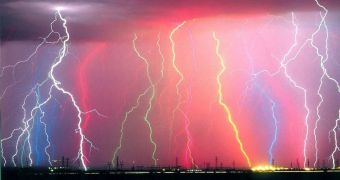The thunderbolt is an electric discharge accompanied by a vivid light and a powerful sound, which occurs between two clouds or between a cloud and the ground or objects on the ground. The thunder is a noise accompanying an atmospheric electric discharge (lightening or thunderbolt). The lightning is a luminous electric discharge produced by two clouds or inside a cloud.
During a strong storm, 8,000-9,000 electric discharges take place in one hour. Daily, 8 million lightnings are produced in the atmosphere. In the mountain zones, lightnings can reach a maximum length of 100 m (330 ft) while in the plain they can measure even 30 km (19 mi). The average length of a lightning is of 2-3 km (1.2-1.9 mi).
A lightning lasts, on average, 0.00004 seconds. The strongest lightnings ever recorded had a duration of 0.001 seconds. The fact that we perceive the lightning as a powerful light of about one second is just an optic illusion caused by the reaction of the eye retina. Lightnings kill 100 persons in US annually, and injure another 250.
The thunderbolt is not unitary; it can be made of up to 42 simultaneous main discharges, each of them being preceded by a conductor thunderbolt. During the electric discharges, a huge amount of energy is released. In some cases, it is about 1,000 million volts, and the intensity of the electric current may be of 20,000 Ampers.
Concerning the trees, the thunderbolt has its preferences, the first place being occupied by the oak. At the opposite pole, the most avoided trees are the birch and the laurel. This predilection is directly connected to the profundity of the roots.
The zig-zag shape of the thunderbolt is due to the fact that the rarefied air is a better conductor for the electricity than the compressed air. Passing through portions of rarefied air, its enormous heat causes other compressions and rarities, having to change its trajectory constantly. That's why you'd better not run when caught by a storm with thunderbolts.

 14 DAY TRIAL //
14 DAY TRIAL //